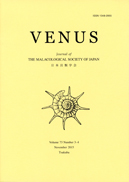Volume 71, Issue 1-2
Displaying 1-13 of 13 articles from this issue
- |<
- <
- 1
- >
- >|
Original Articles
-
Article type: Original Article
2013Volume 71Issue 1-2 Pages 1-11
Published: January 31, 2013
Released on J-STAGE: May 31, 2016
Download PDF (1425K) -
Article type: Original Article
2013Volume 71Issue 1-2 Pages 13-27
Published: January 31, 2013
Released on J-STAGE: May 31, 2016
Download PDF (1924K) -
Article type: Original Article
2013Volume 71Issue 1-2 Pages 29-37
Published: January 31, 2013
Released on J-STAGE: May 31, 2016
Download PDF (1335K) -
Article type: Original Article
2013Volume 71Issue 1-2 Pages 39-47
Published: January 31, 2013
Released on J-STAGE: May 31, 2016
Download PDF (1597K) -
Article type: Original Article
2013Volume 71Issue 1-2 Pages 49-59
Published: January 31, 2013
Released on J-STAGE: May 31, 2016
Download PDF (2323K) -
Article type: Original Article
2013Volume 71Issue 1-2 Pages 61-79
Published: January 31, 2013
Released on J-STAGE: May 31, 2016
Download PDF (801K) -
Article type: Original Article
2013Volume 71Issue 1-2 Pages 81-95
Published: January 31, 2013
Released on J-STAGE: May 31, 2016
Download PDF (702K) -
Article type: Original Article
2013Volume 71Issue 1-2 Pages 97-103
Published: January 31, 2013
Released on J-STAGE: May 31, 2016
Download PDF (890K)
Short Notes
-
Article type: Short Note
2013Volume 71Issue 1-2 Pages 105-108
Published: January 31, 2013
Released on J-STAGE: May 31, 2016
Download PDF (913K) -
Article type: Short Note
2013Volume 71Issue 1-2 Pages 109-112
Published: January 31, 2013
Released on J-STAGE: May 31, 2016
Download PDF (727K) -
Article type: Short Note
2013Volume 71Issue 1-2 Pages 113-116
Published: January 31, 2013
Released on J-STAGE: May 31, 2016
Download PDF (924K) -
Article type: Short Note
2013Volume 71Issue 1-2 Pages 117-120
Published: January 31, 2013
Released on J-STAGE: May 31, 2016
Download PDF (804K) -
Article type: Short Note
2013Volume 71Issue 1-2 Pages 121-123
Published: January 31, 2013
Released on J-STAGE: May 31, 2016
Download PDF (608K)
- |<
- <
- 1
- >
- >|
